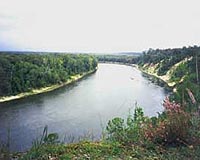 |
Madison WI (SPX) Jun 26, 2009 Dissolved organic carbon (DOC) losses from tile drains are an underquantified portion of the terrestrial carbon cycle. This is particularly important in the eastern corn belt where tile drainage dominates the agricultural landscape. Specific land management practices, such as manure application, can play a large role in the export of DOC as soluble organic carbon is applied to or injected into the soil surface. As animal agriculture intensifies in the upper Midwest, measuring DOC exported through tile drains is important when evaluating carbon budgets and carbon sequestration potential. Scientists at Purdue University have investigated the impacts of manure application, crop rotation, and nitrogen application rate on DOC losses from tile drains. Research was conducted over a six-year span (1998-2004) at Purdue University's Water Quality Field Station, which was designed specifically to measure drainflow and solute losses from agricultural practices. Forty-eight drainage lysimeters were established at the field site in 1992. Twelve field treatments included a restored prairie grass, continuous corn rotations and corn-soybean rotations fertilized at three nitrogen rates, and continuous corn rotations fertilized with lagooned swine effluent applied in the spring or fall of each year. The study was funded by the USDA through Consortium for Agricultural Soils Mitigation of Greenhouses program and through the CSREES-NRI Watershed Processes and Water Resources Grant; the results were published in the May issue of the Journal of Environmental Quality. The study determined that annual losses of DOC were not affected by any crop management practice. However, when drainage-inducing rainfall occurred with one month of manure application, the monthly DOC concentration of the manured plot was greater than that of non-manured plots. Overall, drainage hydrology was determined to be the largest sole driver of DOC loss. Greater daily drainflows were associated with higher DOC concentrations compared to lower daily drainflows. This indicates that larger storms effectively "flush" DOC from the soil systems. Dr. Matt Ruark, now an Assistant Professor at the University of Wisconsin-Madison, stated, "Understanding the concentrations and amounts of DOC contributed to surface waters from tile drains is essential for evaluating the overall aquatic ecology of a watershed. This is of particular importance in the eastern corn belt, where up to 80% of the land in agricultural watersheds are tile drained." Further research is required to evaluate the fate of tile drainage-exported DOC once it enters the surface water system. The effect of manure management on the availability of DOC leached into subsurface soil is currently being investigated. Ongoing research at the water quality field station is being conducted to quantify nutrient and contaminant losses in tile drains as a result of manure application and crop rotation. Share This Article With Planet Earth
Related Links Crop Science Society of America (CSSA) Farming Today - Suppliers and Technology
 Low Apalachicola River Flow May Hurt Gulf Fisheries
Low Apalachicola River Flow May Hurt Gulf FisheriesTallahassee FL (SPX) Jun 26, 2009 Reductions in the flow of the Apalachicola River have far-reaching effects that could prove detrimental to grouper and other reef fish populations in the northeastern Gulf of Mexico, according to a new Florida State University study that may provide new ammunition for states engaged in a nearly two-decade water war. The Florida State researchers found that in years with low river flow, the ... read more |
|
| The content herein, unless otherwise known to be public domain, are Copyright 1995-2009 - SpaceDaily. AFP and UPI Wire Stories are copyright Agence France-Presse and United Press International. ESA Portal Reports are copyright European Space Agency. All NASA sourced material is public domain. Additional copyrights may apply in whole or part to other bona fide parties. Advertising does not imply endorsement,agreement or approval of any opinions, statements or information provided by SpaceDaily on any Web page published or hosted by SpaceDaily. Privacy Statement |